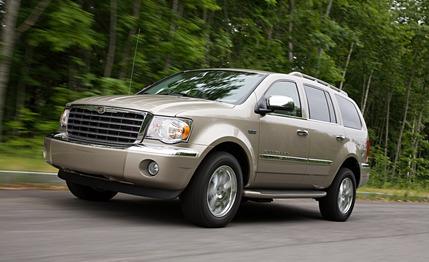 First Drive Review
First Drive Review
A lot more people are considering hybrids these days—but for $45,000? The big price tag makes Chrysler’s first hybrids, the Dodge Durango and the Chrysler Aspen, a much tougher sell. And GM has already somewhat proved this notion with its extremely slow-selling, $50,000 Chevy Tahoe and GMC Yukon hybrids.
GM’s mammoth hybrids aren’t simply the competition in this new segment; the Chrysler SUVs use the same GM-designed two-mode hybrid system—developed jointly with GM, Chrysler, Daimler, and BMW—that pairs two electric motors with a traditional four-speed automatic for roughly 25-percent gains in overall fuel economy.
A Simpler Approach
In the Tahoe and Yukon hybrids, GM went to great lengths to offset the 350-pound weight penalty from all the hybrid gear, installing lighter seats and wheels, a smaller 12-volt battery, and lighter aluminum for the hood, liftgate, and front bumper beam. Chrysler did nothing to battle weight, and, sure enough, the Durango/Aspen’s heft climbs 400 pounds to about 5700. The biggest contributors are the 150-pound battery, two 75-pound, 87-hp electric motors, and roughly 40 pounds of electrical plumbing. That’s not a good start for improving fuel economy.
Furthermore, the GM utes get a high-efficiency Atkinson-cycle version of the 6.0-liter small-block V-8, whereas the Chrysler utes simply get the standard Hemi. Okay, make that the updated-for-2009 Hemi, with variable cam timing and improved airflow, as well as cylinder deactivation. The hybrids have a different intake than other ’09s and make 345 horsepower versus 356 for the Hemi-equipped ’09 Durango. Total output combined with the electric motors is 385 horsepower, although with the added weight and taller final-drive ratio, Chrysler predicts the hybrids will be slower than comparable nonhybrid Hemi models.
The Chrysler hybrids come only with four-wheel drive (GM offers a choice of two- and four-wheel drive) because, according to chief engineer Bob Feldmaier, “it didn’t make sense from a cost and complexity standpoint.” In fact, the two utes come essentially fully loaded, the only options being a rear DVD system, a sunroof, and a towing package.
Large Fuel-Economy Gains
On the EPA cycle, the Durango and the Aspen are rated at 19 mpg city and 20 highway. Compared with the standard Hemi’s figures (13 city/18 highway), that’s a 46-percent gain in the city and 11 percent on the highway, which is particularly impressive considering that the four-wheel-drive Tahoe, which is far more sophisticated, is rated at 20 mpg for both city and highway. However, the Chrysler utes benefit from being smaller and starting out more than 500 pounds lighter.
This unique two-mode hybrid arrangement allows the transmission to function either as a continuously variable unit (CVT) in two distinct ratio spreads—from infinity to 1.70 for taking off from a stop and from 1.70 to 0.50 for high-speed efficiency—or as a traditional automatic through one of the four fixed ratios. The powertrain electronics continuously sort out in real time which mode to operate in to maximize economy.
As with other so-called full hybrids, the Chryslers shut down the gas engine at low speeds and can drive on electric power only, in this case at speeds up to 25 mph, and use their electric motors to recapture energy under braking. A further efficiency boost is that the additional power provided by the battery allows the Hemi to stay in four-cylinder mode more often, even at highway speeds.